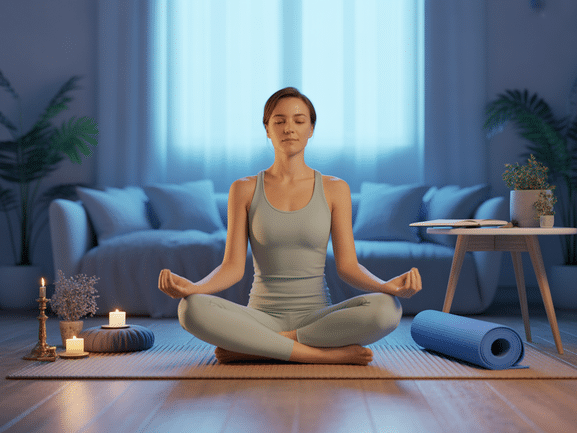Yoga Philosophy at Home: Discovering Your Spiritual Essence Through Online Practice
Have you ever wondered if there’s more to yoga than just stretching and physical postures? The answer is absolutely yes! While yoga has gained popularity as a form of exercise, its true essence lies in ancient spiritual philosophy that can transform your life from within. Today, we’ll explore how you can discover and practice yoga philosophy at home, creating a deeper connection with yourself through online guidance.
Furthermore, practicing spiritual yoga at home offers unique advantages: you can create your own sacred space, practice at your own pace, and dive deep into philosophical teachings without external distractions. Let’s embark on this transformative journey together.
Understanding the True Essence of Yoga
The word “yoga” comes from the Sanskrit root “yuj,” meaning “to unite” or “to join.” This ancient practice is designed to unite the mind, body, and spirit, creating harmony within ourselves and with the universe. When you practice yoga philosophy for beginners at home, you’re not just moving your body – you’re embarking on a spiritual journey of self-discovery.
“Yoga is not about touching your toes. It’s about learning on the way down.” – Judith Hanson Lasater
Traditional yoga encompasses eight limbs (Ashtanga), which provide a comprehensive framework for living a meaningful and purposeful life. These limbs work together to guide practitioners toward spiritual enlightenment and inner peace.
The Eight Limbs of Yoga: Your Home Practice Guide
Understanding the eight limbs of yoga is essential for anyone seeking to deepen their spiritual yoga practice. Here’s how you can incorporate each limb into your home routine:
1. Yamas (Ethical Restraints)
The Yamas are moral guidelines that help us live in harmony with others. They include:
- Ahimsa (Non-violence): Practice compassion toward yourself and others, including choosing kind words and actions
- Satya (Truthfulness): Live authentically and speak your truth with kindness
- Asteya (Non-stealing): Respect others’ time, energy, and possessions
- Brahmacharya (Energy management): Use your energy wisely and mindfully
- Aparigraha (Non-possessiveness): Practice gratitude and contentment with what you have
2. Niyamas (Observances)
These are positive practices that cultivate inner discipline:
- Saucha (Cleanliness): Maintain physical and mental purity
- Santosha (Contentment): Find joy in the present moment
- Tapas (Disciplined practice): Commit to regular practice
- Svadhyaya (Self-study): Study sacred texts and engage in self-reflection
- Ishvara Pranidhana (Surrender to the divine): Let go of ego and trust the process
3. Asana (Physical Postures)
While most people associate yoga with asanas, they’re actually just one part of the spiritual journey. Practice postures mindfully, using them as moving meditation to prepare your body for deeper spiritual work.
4. Pranayama (Breath Control)
Conscious breathing is the bridge between body and mind. Practice simple breathing techniques like:
- Three-part breath (Dirga Pranayama)
- Ocean breath (Ujjayi Pranayama)
- Alternate nostril breathing (Nadi Shodhana)
These practices can easily be incorporated into your yoga meditation online sessions, helping you develop greater awareness and inner calm.
Creating Your Sacred Home Practice Space
One of the beautiful aspects of practicing home yoga spirituality is the ability to create your own sacred space. This doesn’t require a large area or expensive equipment – just intention and consistency.
Essential Elements for Your Spiritual Practice Space:
- Quiet corner: Choose a peaceful area free from distractions
- Clean environment: Keep the space tidy and clutter-free
- Natural light: Position near a window if possible
- Comfortable seating: A meditation cushion or yoga mat
- Inspiring objects: Candles, crystals, plants, or meaningful photos
- Journal: For reflection and tracking your spiritual growth
Moreover, having a dedicated space signals to your mind that this is time for spiritual practice, helping you transition more easily into a meditative state.
Incorporating Meditation and Mindfulness
Meditation is the heart of yoga philosophy, and fortunately, it’s perfectly suited for home practice. Start with just 5-10 minutes daily and gradually increase the duration as your practice deepens.
Simple Meditation Techniques for Beginners:
- Mindful breathing: Focus on the natural rhythm of your breath
- Body scan: Systematically relax each part of your body
- Loving-kindness: Send compassionate thoughts to yourself and others
- Mantra repetition: Use sacred sounds like “Om” or “So Hum”
In addition, practicing yoga meditation online with guided sessions can provide structure and support as you develop your practice. The Vitalizen.app platform offers comprehensive meditation programs designed specifically for home practitioners seeking spiritual growth.
The Spiritual Benefits of Online Yoga Practice
Practicing yoga philosophy at home offers unique spiritual benefits of online yoga that complement traditional in-person instruction:
Privacy for Deep Introspection
At home, you can explore your emotions and spiritual insights without feeling self-conscious. This privacy allows for authentic self-discovery and genuine spiritual growth.
Consistency and Routine
Having access to online resources eliminates barriers like travel time and scheduling conflicts, making it easier to maintain a consistent practice – the foundation of spiritual development.
Personalized Pace
You can repeat lessons, spend extra time on challenging concepts, or accelerate through familiar material according to your spiritual needs and timeline.
Additionally, online platforms often provide extensive libraries of philosophical teachings, allowing you to explore different aspects of yoga wisdom at your own pace.
How Vitalizen Supports Your Spiritual Journey
Understanding how to practice yoga philosophy at home

